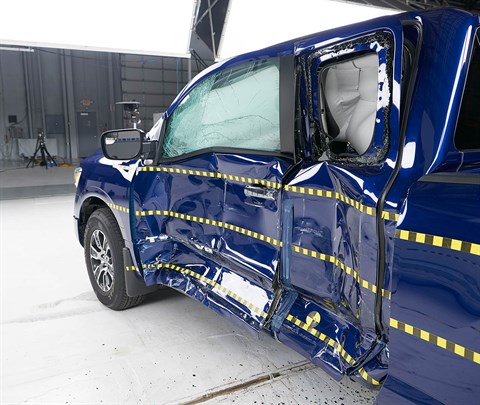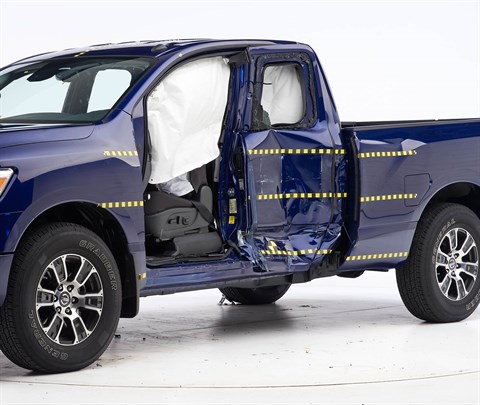Small overlap front: driver-side
Rating applies to 2020-24 models
Tested vehicle: 2020 Nissan Titan SV Crew Cab
The Nissan Titan Crew Cab (light-duty pickup with a gasoline engine) was redesigned for the 2017 model year after a one-year absence from the market. Beginning with 2017 models built after August 2017, the front-end structure was modified to improve occupant protection in small overlap crashes.
Further improvements were implemented beginning with 2020 models to include new side airbags, driver and passenger frontal airbags, and driver-side knee airbags. Additionally, new rear seatbelts were added and changes were made to the front frame structure, hinge pillar, roof rail, and lower sill. (Information about when a specific vehicle was manufactured is on the certification label typically affixed to the car on the driver door or adjacent B-pillar.)
Driver-side small overlap frontal ratings are assigned by the Institute based on a test of a 2020 Nissan Titan conducted by Nissan.
| Evaluation criteria | Rating |
|---|---|
| Structure and safety cage | |
| Driver injury measures | |
| Head/neck | |
| Chest | |
| Hip/thigh | |
| Lower leg/foot | |
| Driver restraints and dummy kinematics | |
Small overlap front: passenger-side
Rating applies to 2021-24 models built after September 2020
Tested vehicle: 2021 Nissan Titan SV King Cab
The Nissan Titan King Cab (light-duty pickup with a gasoline engine) was redesigned for the 2017 model year after a one-year absence from the market. Beginning with 2017 models built after August 2017, the front-end structure was modified to improve occupant protection in small overlap crashes.
Further improvements were implemented beginning with 2020 models to include new side airbags, driver and passenger frontal airbags, and driver-side knee airbags. Additionally, new rear seatbelts were added and changes were made to the front frame structure, hinge pillar, roof rail, and lower sill.
Beginning with 2021 models built after September 2020, passenger-side knee airbags were added to improve occupant protection in passenger-side small overlap frontal crashes. (Information about when a specific vehicle was manufactured is on the certification label typically affixed to the car on the driver door or adjacent B-pillar.)
Passenger-side small overlap frontal ratings are assigned by the Institute based on a test of a 2021 Nissan Titan conducted by Nissan.
| Evaluation criteria | Rating |
|---|---|
| Overall evaluation | |
| Structure and safety cage | |
| Passenger injury measures | |
| Head/neck | |
| Chest | |
| Hip/thigh | |
| Lower leg/foot | |
| Passenger restraints and dummy kinematics | |
| Driver injury measures | |
| Head/neck | |
| Chest | |
| Hip/thigh | |
| Lower leg/foot | |
| Driver restraints and dummy kinematics | |
Moderate overlap front: original test
Rating applies to 2020-24 models
Tested vehicle: 2020 Nissan Titan SV Crew Cab
The Nissan Titan Crew Cab (light-duty pickup with a gasoline engine) was redesigned for the 2017 model year after a one-year absence from the market. Beginning with 2017 models built after August 2017, the front-end structure was modified to improve occupant protection in small overlap crashes.
Further improvements were implemented beginning with 2020 models to include new side airbags, driver and passenger frontal airbags, and driver-side knee airbags. Additionally, new rear seatbelts were added and reinforcements were made to the front frame structure, hinge pillar, roof rail, and lower sill. (Information about when a specific vehicle was manufactured is on the certification label typically affixed to the car on the driver door or adjacent B-pillar.)
Moderate overlap frontal ratings are assigned by the Institute based on a test of a 2020 Nissan Titan conducted by Nissan.
| Evaluation criteria | Rating |
|---|---|
| Overall evaluation | |
| Structure and safety cage | |
| Driver injury measures | |
| Head/neck | |
| Chest | |
| Leg/foot, left | |
| Leg/foot, right | |
| Driver restraints and dummy kinematics | |
Side: original test
Rating applies to 2020-24 models
Tested vehicle: 2020 Nissan Titan SV Extended Cab
The Nissan Titan King Cab (light-duty pickup with a gasoline engine) was redesigned for the 2017 model year after a one-year absence from the market.
Beginning with 2020 models new side airbags, driver and passenger frontal airbags, and driver-side knee airbags were added to improve occupant protection in frontal and side crashes. Additionally, new rear seatbelts were added and reinforcements were made to the roof rail and lower sill. (Information about when a specific vehicle was manufactured is on the certification label typically affixed to the car on the driver door or adjacent B-pillar.)
Side ratings are assigned by the Institute based on three tests of the Nissan Titan, one conducted by the Institute and two by Nissan. Because the structure was not changed, the structure rating is based on this test and two tests of the Nissan Titan conducted by Nissan.
| Evaluation criteria | Rating |
|---|---|
| Overall evaluation | |
| Structure and safety cage | |
| Driver injury measures | |
| Head/neck | |
| Torso | |
| Pelvis/leg | |
| Driver head protection | |
| Rear passenger injury measures | |
| Head/neck | |
| Torso | |
| Pelvis/leg | |
| Rear passenger head protection | |

View of the vehicle just after the crash test.

View of the vehicle after the crash with doors removed, showing the side airbags and damage to the occupant compartment.

Smeared greasepaint shows where the driver dummy's head was protected from being hit by hard structures by the side airbags.

Smeared greasepaint shows where the rear passenger dummy’s head was protected by the side airbag.
Head restraints & seats
Seat type: Manual cloth seat
| Overall evaluation | |
|---|---|
| Dynamic rating | |
| Seat/head restraint geometry |
About the head restraint & seat test
Currently, IIHS tests apply only to front seats.
Headlights
Ratings are given for 2 different headlight variations available on this vehicle.
Trim level(s)
- S trim
- SV trim
| Evaluation criteria | Rating |
|---|---|
| Low-beam headlight type | Halogen reflector |
| High-beam headlight type | Halogen reflector |
| Curve-adaptive? | No |
| High-beam assist? | Yes |
|
Overall rating | |
| Distance at which headlights provide at least 5 lux illumination: | |
Low beams
On the straightaway, visibility was fair on both sides of the road. On curves, visibility was inadequate in all 4 tests.
The low beams created excessive glare.
High beams
On the straightaway, visibility was inadequate on both sides of the road. On curves, visibility was inadequate in all 4 tests.
High-beam assist compensates for some limitations of this vehicle's low beams on the straightaway and all 4 curves.
Trim level(s)
- PRO-4X trim
| Evaluation criteria | Rating |
|---|---|
| Low-beam headlight type | LED projector |
| High-beam headlight type | LED projector |
| Curve-adaptive? | No |
| High-beam assist? | Yes |
|
Overall rating | |
| Distance at which headlights provide at least 5 lux illumination: | |
Low beams
On the straightaway, visibility was good on the left side of the road and fair on the right side. On curves, visibility was good on both right curves and fair on both left curves.
The low beams created excessive glare.
High beams
On the straightaway, visibility was good on both sides of the road. On curves, visibility was good on the gradual right and gradual left curves and fair on the sharp right and sharp left curves.
High-beam assist compensates for some limitations of this vehicle's low beams on the straightaway and all 4 curves.
